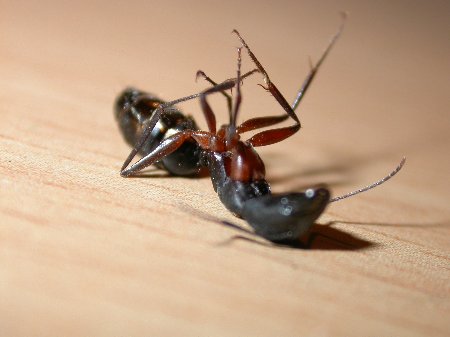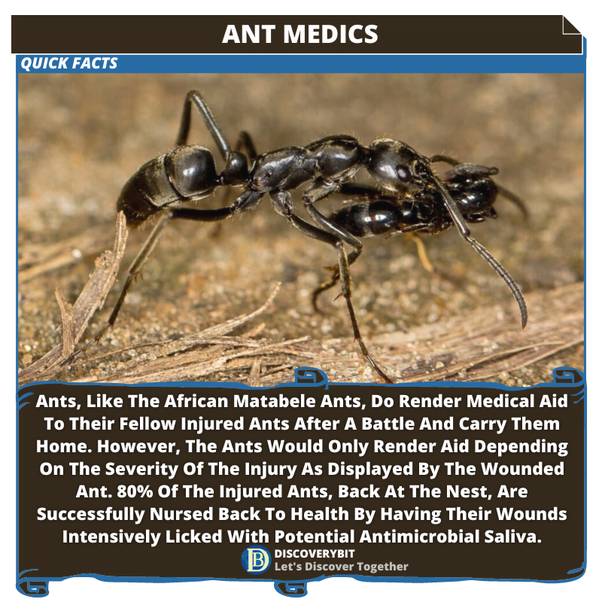When an ant dies, other ants carry the body away to a designated waste site. This behavior is known as necrophoresis.
Ants have a highly structured society where each individual plays a role, even after death. Necrophoresis serves both a practical and a health purpose within an ant colony. By removing deceased members from the colony, ants prevent the spread of disease and maintain a clean environment.
This disposal task typically falls to a specialized group of worker ants tasked with colony sanitation. This instinctive undertaking exemplifies the complex social behaviors of ants, highlighting their advanced communication systems and collective approach to colony maintenance. Understanding these behaviors provides fascinating insights into the roles and responsibilities that govern an ant colony’s survival and efficiency.

Credit: www.orderofthegooddeath.com
Ants’ Death Trigger
Ever wondered what happens in an ant colony when an individual ant dies? The process is as fascinating as it is efficient. Ants have developed a highly effective way to deal with their dead, thanks to a sophisticated chemical communication system.
Chemical Signals: The Ants’ Alert System
Ants are chemical conversation experts. They rely on their well-developed olfactory systems for virtually every aspect of their social lives. This includes detecting when a fellow ant has died. The key to this system is a substance called oleic acid.
When an ant dies, its body starts to release oleic acid. This ‘death chemical’ acts like an alarm bell, signaling other ants to spring into action. Their response is immediate and clear:
- They recognize the dead ant through this chemical.
- They carry the body away from the colony.
- They dispose of it in a designated area, known as an ant graveyard.
Identifying The Death: How Ants Know
But how can ants identify the exact moment another ant has died? Scientists believe it all boils down to the chemicals every ant body produces.
| Living Ant | Dead Ant |
|---|---|
| Emits a blend of chemicals | Emits oleic acid |
| Active in the colony | Removed from the colony |
| Part of daily life | Part of afterlife procedures |
Oleic acid isn’t present in high concentrations in a living ant. The moment the ant’s life ends, the absence of life-sustaining processes causes an increase in this chemical. As a result, other ants quickly identify this change. They respond effectively to maintain the cleanliness and health of the colony. Treating the dead properly ensures diseases do not spread throughout the community.
Dead Ant Transport Protocol
Within the organized world of ants, Dead Ant Transport Protocol dictates how they manage their deceased members. This ensures the health and cleanliness of the colony. Ants have evolved a distinctive and efficient method to deal with their dead.
Carrying The Fallen: Ant Undertakers
Ants are not only builders and foragers but also skilled undertakers. Upon identifying a dead nestmate, worker ants spring into action.
- Ant undertakers release pheromones to signal their task force.
- The work force quickly locates the deceased.
- Specialized behavior involves assessing and carrying the dead.
Using their strong mandibles, the ant undertakers delicately carry their fallen comrade away from the nest, avoiding contamination.
Journey To The Final Resting Place: Ant Burying Grounds
The destination for these tiny pallbearers is often an ant graveyard, situated at a safe distance from the colony.
- Dead ants are methodically transported to designated burying grounds.
- This prevents diseases from spreading within the colony.
- Sanitary measures like these are crucial for colony survival.
The deceased are laid to rest in an organized manner, ensuring the living ants remain healthy and the nest stays clean.
Ant Graveyards And Necrophoresis
Ants have a unique way to handle the death of a fellow colony member. When an ant dies, its mates spring into action with specific tasks to address the situation. This intricate behavior avoids disease and keeps the colony clean and healthy. This ritual is fascinating and has caught the attention of scientists and nature enthusiasts alike.
Creating A Cemetery: Organizational Behavior
When an ant passes away, colony members quickly establish a designated area to move the deceased. This area, often referred to as an ant cemetery, is usually located far away from the colony’s living quarters. The ants collectively choose this site with great care to prevent contamination of their home and food supplies.
- Each worker has a role in identifying and moving the dead.
- They use chemical signals to communicate about the deceased.
- The location of the cemetery is strategically chosen to protect the colony’s health.
Necrophoresis: The Clean-up Process
Necrophoresis is the term given to the ants’ method of corpse removal. Ants can detect oleic acid, a chemical that dead ants release. This substance signals the need for necrophoresis, prompting worker ants into action.
| Step | Action |
|---|---|
| 1 | Worker identifies dead ant by oleic acid. |
| 2 | Worker transports dead ant to the graveyard. |
| 3 | The body is deposited away from the colony. |
Ants’ disciplined approach to death and sanitation is truly remarkable. It’s a perfect example of nature’s ingenuity in creating self-sustaining ecosystems.

Credit: www.npr.org
Exception To The Rule: Ants And Their Dead
Imagine a world where even in death, there’s a protocol. For ants, this is reality. These tiny creatures showcase fascinating behavior around their deceased. However, some ants don’t always follow the norms. Let’s explore the exceptions to how ants handle their dead comrades.
Variations Across Species
Different ant species treat their dead differently. In leaf-cutter ants, there’s a ritual burial. Carpenter ants partake in a cleanup approach, removing fallen ants from their nests. Fire ants, on the other hand, create refuse piles. These behaviors showcase the biodiversity of ant responses to death.
- Leaf-cutter ants: Perform ritual burials.
- Carpenter ants: Conduct nest clean-ups.
- Fire ants: Create refuse areas.
When Ants Don’t Remove Their Dead
Sometimes, ants change their protocol for the dead. Certain threats or diseases can cause a shift. If a dead ant carries harmful pathogens, it might be left untouched to protect the colony. This exception highlights how ant behavior is adaptable to changing conditions for colony safety.
| Condition | Ant Behavior |
|---|---|
| Healthy Ant | Removed from the nest |
| Harmful Pathogens | Left untouched |
Impact On The Colony
When an ant dies, it greatly affects the colony. Ants are highly social insects. They work together to maintain their community. Understanding how ants handle the passing of a fellow member is fascinating. It shows their commitment to the colony’s well-being.
Maintaining Colony Health
Ants prioritize their colony’s health. When one member dies, they swiftly manage the situation. Dead ants release chemicals. This alerts other ants to the presence of death.
- Necrophoresis is a process ants use to remove the dead.
- They carry deceased ants away from the nest. This prevents disease.
- The deceased are often placed in a specific area. These are known as ant graveyards.
Cleanliness is crucial in ant societies. Removing the dead protects the living from potential threats. This could include bacteria or fungi that the body may attract.
Social Structure And Death
Ants have a complex social structure. Each ant plays a specific role. The death of an ant is more than a simple loss.
Worker ants react quickly to death. They keep the colony functioning smoothly.
| Ant Type | Role | Impact of Death |
|---|---|---|
| Worker | Foraging, caring for young | Minor, as they are numerous |
| Soldier | Colony defense | Moderate, affects security |
| Queen | Colony reproduction | Severe, may endanger colony’s future |
Despite their roles, ants ensure the colony survives. They adapt to the loss, replacing the functions of the deceased. The colony’s ability to persist demonstrates its robust social organization.

Credit: www.newscientist.com
Research Insights
Ants display complex behaviors that continue to fascinate scientists. One area of study focuses on what they do when faced with death in their community. Let’s dive into some intriguing insights garnered from recent research.
Studying Ant Death Rituals
When an ant dies, it often isn’t left ignored by its colony. Researchers have observed a type of ‘funeral’ process carried out by the living ants. The deceased is meticulously carried to a designated final resting area, often referred to as an ant cemetery. These rituals highlight the surprising sophistication within ant colonies.
- Deaths trigger clean-up: Living ants quickly respond to a death, often within hours.
- Ant cemeteries: Specific areas where dead ants are collected and left.
- Avoidance of disease: By removing deceased ants, the colony limits disease spread.
Learning From Ants: Ecological Implications
Ants contribute significantly to their ecosystems, and understanding their death rituals can offer vital ecological insights.
Their behavior emphasizes the importance of sanitation, disease control, and social structure within a colony. It also highlights their role in nutrient cycling as deceased ants decompose and enrich the soil. Studying these practices not only fascinates but also informs better ecological practices.
| Ant Behavior | Ecosystem Impact |
|---|---|
| Carrying dead to cemeteries | Prevents disease, maintains colony health |
| Death recognition | Highlights chemical communication efficacy |
| Soil enrichment | Dead ants decompose, returning nutrients to the earth |
Frequently Asked Questions For What Do Ants Do When Another Ant Dies
Do Ants Know When Another Ant Dies?
Yes, ants can detect when another ant dies by sensing the chemical pheromones released from the corpse. This triggers them to carry away the deceased ant for disposal.
Why Do Ants Move Dead Ants?
Ants move their dead as a sanitary measure to prevent disease spread within the colony. This behavior is known as necrophoresis.
Do Ants Leave Other Ants Behind?
Ants may leave behind sick or injured members to prioritize colony survival. They focus on resources and efficiency, occasionally abandoning those unable to keep up.
What Happens After Ants Die?
After ants die, other ants carry the bodies away to a designated dump area, known as an ant graveyard, to prevent the spread of disease within the colony. Decomposers then break down the dead ants, recycling their nutrients into the ecosystem.
Conclusion
Ants exhibit a fascinating response to their fallen comrades. They recognize death through pheromones, leading to a respectful removal process. This ritual underscores their complex social structures and survival strategies. Understanding these behaviors shines a light on a world teeming with intricate, miniature societies.
Exploring ant culture broadens our view of life’s interconnectedness.

I’m MD Tanvir, and I bring years of expertise gained from working closely with pest control companies to the forefront. My journey in the industry has inspired me to launch Bug Battler, a platform aimed at equipping people with the know-how to combat pests autonomously. Through Bug Battler, I aim to empower individuals with practical insights to tackle pest infestations effectively.

